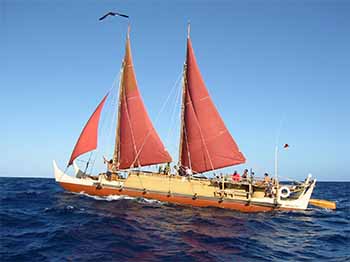Where Do Polynesians Come From ?

How, in a triangle of nearly 10,000 square km formed by what is today Hawaii, Easter Island and New Zealand, have men managed to reach myriads of small islands far from any continent? How could people have lived and prospered there? Where do Polynesians come from ? What is the origin of polynesian culture ?
A submerged continent?
A hypothesis, to answer this question, is born immediately. These men with brown skin and wavy hair have always inhabited these islands. They would belong to an original race and would be the survivors of an immense continent, which a catastrophe would have engulfed. The remaining islands would correspond to the summits of the highest mountains of this extinct continent. Modern techniques for exploring deep waters have shown that this mysterious continent never existed. In addition, studies in anthropology have proven that the autonomous emergence of a race of men was impossible and that the Polynesians could therefore in no case constitute an original human population.
A controversial origin
If the settlement of Polynesia cannot be indigenous, it necessarily comes from migrations. Even today, two theories clash. The first affirms the American origin of the Polynesians. According to the Norwegian prehistorian Thor Heyerdahl, the first inhabitants of the polynesia islands embarked, about a thousand years before our era from the coasts of Peru, to colonize new lands. In order to verify his hypothesis, he himself set sail on a raft to reach the Tuamotu Islands from the Peruvian coast. It is the famous Kon Tiki expedition, named after the boat. The scientist, who left in 1947 from Callao (Peru), reached Oceania after three and a half months of navigation: he proved that the crossing was physically possible. In support of this demonstration, Heyerdahl also puts forward theoretical reasoning: he notes that, until very recently, the food of the Polynesian populations was based essentially on sweet potato. This root does indeed have an American origin.
The Asian cradle
However, neither the navigation of the Norwegian scientist nor the food argument convinced the scientists. Archaeological discoveries made since the 1960s argue in favor of the following route: towards the end of the third millennium BC, the first settlers leave, for reasons still unknown, Southeast Asia.
They infiltrate the archipelagos of the southwest Pacific, already occupied by the Melanesian populations. There, they settled for almost a millennium, learning horticulture from the Melanesians, also of Asian origin. Then, thanks to their large double canoes, they soon discover new uninhabited lands: Fiji, then Tonga and Samoa. At the beginning of our era, too strong demographic pressure, or even wars as the oral tradition still tells, forced the vanquished to go into exile. Many residents head east to discover new lands to conquer in the endless ocean.
Great sailors
Whether voluntary or forced, these trips are carefully prepared. The new settlers, who left Samoa or Tonga, seem to reach first, because of the trade winds and at the cost of many losses and great suffering, the Marquesas Islands. Indeed, it is in the Marquesas that archaeological excavations revealed the oldest known levels of land use (around 300 AD). But not all explorers stop there. From the Marquesas, they continue to sail the ocean on their frail boats and finally settle on all the lands. Thus, until 700 AD, they occupy the Society Islands (Tahiti), Hawaii and Easter Island. Then, between 700 and 1100, a new wave of colonization moved towards the Cook Islands, the Austral Islands and New Zealand.
Once settled on their islands, the Polynesians, separated from other peoples of the Pacific and other continents by immense expanses of water, find themselves protected from invasions and major epidemics - until the arrival of Europeans.
The Polynesian pirogue

No one knows exactly the original shape of the boats and the construction technique that enabled Polynesians to cross the Pacific first. Only the canoes used when Cook or Bougainville discovered these populations can provide us with information. The large travel double canoe is then made up of several hulls. These are tree trunks hollowed out by means of an adze, placed end to end and which can reach 20 to 30 meters in length. All the pieces of wood constituting the canoe are held together by links in woven coconut fluff which pass through holes drilled along the boards. These sewn canoes can hold 10 to 20 people, plus food and animals.









































































































































































































































































































































